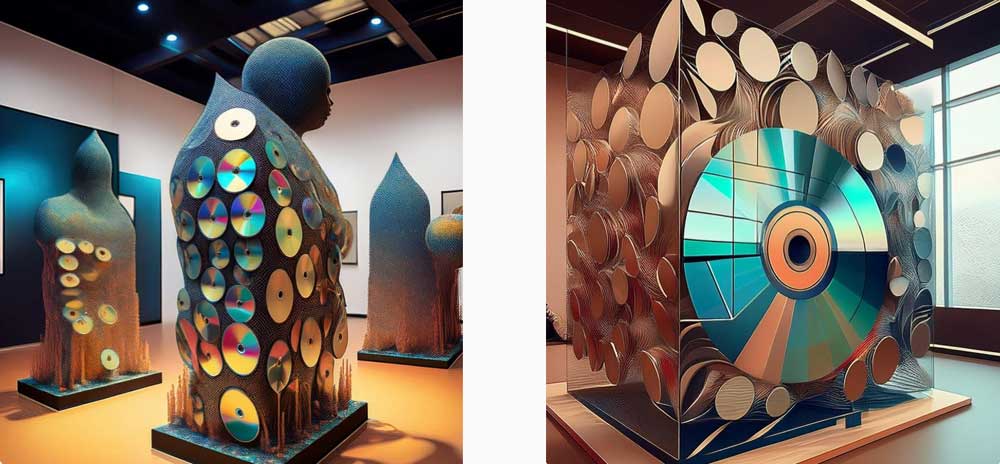
Chelsea Eva Otieno. Leveraging AI for Innovations in Upcycling and Recycling of Compact Discs (CDs). 2024
The theme 'AI Media Innovations, Applications, Visual Culture, Challenges, and Future Trends' comes to life through a series of AI-driven creative explorations. The project features sculptural forms constructed entirely from CD fragments, with Ai systems generating the intricate shapes and structures while providing detailed assembly instructions.
This AI-guided fabrication process allows the sculptures to evolve over time, adapting based on audience interaction and environmental factors. Together, these works explore the transformative potential of AI in upcycling, blending innovative technology with the tactile aesthetics of recycled materials to create a constantly evolving, AI-powered exhibition.
This project explores the intersection of artificial intelligence and environmental sustainability by utilizing Ai to creatively upcycle compact discs (CDs). CDs, when discarded improperly, can harm the environment through burning or landfill waste. This project aims to repurpose these physical CDs into innovative art pieces, reducing environmental impact while exploring the potential of Ai in creative processes.
Process
AI itself is a digital tool, so it doesn’t physically handle the CDs. Instead, it provides the necessary design and arrangement instructions for humans or machines to follow. Here’s how the process works:
- Data Analysis: To analyze the physical CDs, they would first need to be digitized. This would involve scanning or photographing the CDs to create high-resolution digital images. The images should capture details such as color, texture, and reflective properties.
- Data Extraction: Once the CDs are digitized, image processing algorithms can analyze these digital images. AI systems use these algorithms to extract relevant data, such as color values, surface patterns, and reflective qualities.
- Design Generation: Based on the analysis, the Ai generates a design blueprint or pattern for arranging the CDs. This design is created in a digital format, outlining how each CD should be placed to achieve the desired artistic effect.
- Instruction Output: The Ai provides detailed instructions or a digital model that shows the arrangement of CDs. These instructions can be in the form of diagrams, layouts, or 3D visualizations.
- Physical Assembly: Human artists or automated machines use the Ai-generated instructions to physically arrange the CDs according to the design. This step involves translating the digital design into the physical world by placing each CD in the specified position. Ai can continue to adapt the designs based on feedback.
In essence, the AI provides the creative blueprint, while the physical CDs become the medium through which the Ai's digital vision is brought to life. The interaction is a merge between virtual ideas and the tangible materials, where the AIi's digital creativity directs the physical assembly of the CDs, merging the two realms into one cohesive artwork. By guiding the creative process, the AI ensures that the CDs are upcycled into something meaningful and beautiful, thereby preventing them from ending up in landfills or being burned, which would harm the environment. This process not only gives the CDs a second life, but also demonstrates how technology can be leveraged to address environmental concerns through creative solutions.

Concept
AI generates intricate designs for sculptures made entirely from CD fragments. These designs guide the physical assembly of CDs, creating evolving, adaptive art that responds to environmental factors and audience feedback. The result is a constantly transforming exhibition that highlights the potential of upcycling in reducing environmental harm.
Prompt
AI-Generated CD Sculptures: Design a compelling series of sculptural forms made entirely from CD fragments. Utilize an advanced Ai system to generate intricate and unique shapes and structures for these sculptures that offers an evolving interactive experience, showcasing the dynamic and innovative capabilities of Ai-driven art.
AI sites used
- Adobe Firefly - Image generations and designs
- Ideogram - Image generation and designs
- ChatGpt - Research

Conclusion
Leveraging AI in this way not only showcases innovative uses of technology in art, but also addresses pressing environmental concerns. Through this project, CDs are transformed from discarded objects into valuable artistic expressions, all guided by the creative capabilities of AiÍ. This intersection of technology, art, and sustainability sets a precedent for future projects that aim to minimize waste and maximize creativity.

CHELSEA EVA OTIENO
As a child, I was captivated by the magic of visual storytelling, a passion that has flourished into a dedicated career in Graphic Design. Driven by an unwavering commitment to creating designs that are visually stunning and emotionally engaging, I’ve built a strong foundation in Graphic Design. I have honed my skills in crafting intricate and compelling visual narratives. Each project offers a new opportunity to explore creative horizons and push the boundaries of traditional design. What inspires me most is the chance to capture the essence of brands and bring stories to life through art. Every design is a journey, and I am dedicated to making each one a unique and impactful experience. My work reflects my passion for visual communication and my desire to connect deeply with audiences through thoughtful, innovative design. As I continue to grow in my field, I am particularly intrigued by the evolving landscape of Ai Media Innovations, Applications, Visual Culture, Challenges, and Future Trends. This theme resonates deeply with my belief in the potential of Ai to enhance visual storytelling. I strive to incorporate these cutting-edge advancements into my work, ensuring that my designs not only resonate emotionally but also embrace the future of visual communication.
